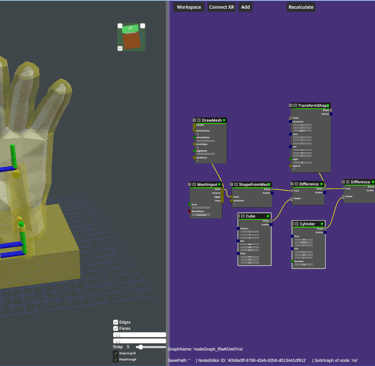Understanding CAD Nodes: A Procedural Node-Based CAD Solution
Quick explanation on what a node based flow is about
2/22/20242 min read


In the world of computer-aided design (CAD), there are various approaches to generating and manipulating geometry. One such approach is the node-based flow, which offers a powerful and intuitive way to control the design process. A prime example of this is Blender's Geometry Nodes, a robust tool that showcases the capabilities of a node-based CAD solution. Node-based flow, in the context of generating geometry, involves connecting different nodes together to create a network of operations. Each node represents a specific function or operation, such as transforming, modifying, or generating geometry. By linking these nodes in a visual graph, designers can easily manage the operation flow and visualize the exact calculation model needed to achieve the desired result. The benefits of using a node-based flow in CAD design are numerous. Firstly, it allows for a more intuitive and visual approach to designing 3D models. Instead of relying solely on complex mathematical equations or code, designers can manipulate nodes and their connections directly, making it easier to understand and modify the design process. Additionally, the node-based flow offers a high level of flexibility and adaptability. Designers can easily modify and rearrange the nodes to experiment with different design variations, without the need to start from scratch. This flexibility enables faster iteration and exploration of design ideas, ultimately leading to more efficient and creative workflows. Furthermore, the procedural approach, which is an extension of the parametric approach, brings additional benefits to the CAD design process. While parametric design allows for the creation of models based on predefined parameters, the procedural approach takes it a step further by allowing designers to create models based on algorithms and rules. This means that the design can be dynamically adjusted based on changing parameters, making it highly adaptable and responsive to design changes. CAD Nodes, as a procedural node-based CAD solution, takes advantage of these benefits and more. Its multi-platform nature, including web and mixed reality capabilities, allows designers to access and work on their projects from various devices and environments. This flexibility enhances collaboration and accessibility, making CAD Nodes a versatile tool for designers across different industries. In conclusion, the node-based flow in CAD design, exemplified by tools like Blender's Geometry Nodes, offers a powerful and intuitive way to control the design process. With its visual and flexible nature, designers can easily manage operation graphs and visualize the calculation models needed to achieve their desired results. The procedural approach, an extension of parametric design, further enhances the design process by enabling dynamic adjustments and adaptability. CAD Nodes, with its multi-platform capabilities, provides designers with a versatile solution for their CAD needs, accessible across web and mixed reality environments.
